| |
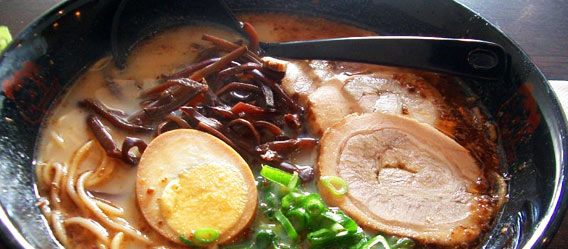
When thinking about Japanese cuisine, one typically think of all the great Japanese bento dishes, the sushi rolls, or even onigiri (rice balls), but there are many varieties of Japanese noodle dishes in Japanese cuisine that are popular in Japan.
Noodles are a staple part of Japanese cuisine and can be found in all parts of Japan and during all seasons. This month, we will look at different types of Japanese noodles and their history.
Ramen Noodles
 The name ramen is the Japanese pronunciation of the northern Chinese noodle “la mian”. It is believed that ramen was imported into Japan during the Meiji period. Ramen noodles are thin firm noodles that are made from wheat flour, salt, water, and kansui, a form of alkaline water commonly used to make Chinese wheat noodles. The name ramen is the Japanese pronunciation of the northern Chinese noodle “la mian”. It is believed that ramen was imported into Japan during the Meiji period. Ramen noodles are thin firm noodles that are made from wheat flour, salt, water, and kansui, a form of alkaline water commonly used to make Chinese wheat noodles.
Beginning in the early 1900, Chinese cuisine began gaining popularity in Japan, and a form of hand cut noodles was introduced. After World War II, when flour was imported cheaply from the U.S into Japan and soldiers returning from China and the East Asian continent had become familiar with Chinese cuisine, ramen became highly popular as a dish to enjoy when eating out.
Ramen noodles are usually eaten with a broth soup base that varies according to region. The most common ramen broth soup bases include:
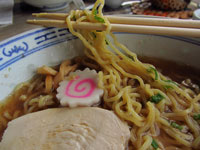 Shio which can be translated to mean salt. This is the oldest form of soup base and is a clear broth made with salt, chicken, vegetables, fish, and seaweed. Tonkotsu, a milky soup base made from boiling pork bones, fats and collagen over high heat for many hours is a very rich, creamy and tasty soup base that originated from Kyushu in Southern Japan. Shoyu which can be translated to mean soy sauce is another popular ramen soup base. It is a clear brown broth made with chicken and vegetable base with soy sauce added for flavor. Shoyu soup base gives a tangy, salty and savory flavor that is light and subtle. Shio which can be translated to mean salt. This is the oldest form of soup base and is a clear broth made with salt, chicken, vegetables, fish, and seaweed. Tonkotsu, a milky soup base made from boiling pork bones, fats and collagen over high heat for many hours is a very rich, creamy and tasty soup base that originated from Kyushu in Southern Japan. Shoyu which can be translated to mean soy sauce is another popular ramen soup base. It is a clear brown broth made with chicken and vegetable base with soy sauce added for flavor. Shoyu soup base gives a tangy, salty and savory flavor that is light and subtle.
Soba Noodles
Soba is the Japanese word for buckwheat and refers to the thin chewy noodles made from buckwheat. Soba is produced mainly in Hokkaido in Northern Japan. Soba made from newly harvested soba is known as “shin-soba” in Japan and is known for their sweeter and more flavorful taste.
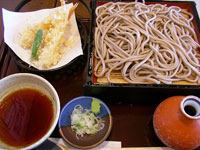 In summer, soba is often served chilled. Chilled soba is typically served over a bamboo sieve tray, known as the zaru. The noodles are often served with seaweed and sometimes sesame garnishing. A dipping sauce known as soba tsuyu is served on the side for dipping the chilled soba noodles in. Soba Tsuyu is often made with dashi (Japanese stock broth), sweetened soy sauce and mirin. Wasabi and scallions are often added into the tsuyu. To enjoy, diners pick up strands of soba noodles and dip them into the tsuyu and swirl the noodles around in the sauce for flavor before eating. In summer, soba is often served chilled. Chilled soba is typically served over a bamboo sieve tray, known as the zaru. The noodles are often served with seaweed and sometimes sesame garnishing. A dipping sauce known as soba tsuyu is served on the side for dipping the chilled soba noodles in. Soba Tsuyu is often made with dashi (Japanese stock broth), sweetened soy sauce and mirin. Wasabi and scallions are often added into the tsuyu. To enjoy, diners pick up strands of soba noodles and dip them into the tsuyu and swirl the noodles around in the sauce for flavor before eating.
Many people feel that the unique chewy texture and nutty flavor of soba noodles are best enjoyed chilled. While hot soba noodles served in hot broth is also highly popular, most people prefer the experience of having chilled soba. Often times, diners enjoy the broth that the soba was cooked in (known as sobayu) with left over tsuyu after finishing the noodles.
Udon Noodles
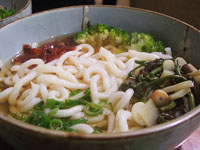 Udon is a highly popular thick white wheat noodle found in Japanese cuisine. There are two popular stories on the origin of udon noodles. One story states that Udon was introduced into Japan in 1241 A.D, by a Rinzai zen monk who introduced flour-milling technology into Japan. This allowed flour to be made into noodles such as soba and udon and allowed for the creation of pancakes for locals to create delicious dishes. The second story states that udon was introduced into Japan during the Nara period (710 to 794 A.D) when a Japanese envoy on a visit to China was introduced to 14 different kinds of confectionary during the Tang dynasty of China. One type of confectionary is known as sakubei and is believed to be the predecessor of udon noodles and other forms of noodles in Japan according to this story. Udon is a highly popular thick white wheat noodle found in Japanese cuisine. There are two popular stories on the origin of udon noodles. One story states that Udon was introduced into Japan in 1241 A.D, by a Rinzai zen monk who introduced flour-milling technology into Japan. This allowed flour to be made into noodles such as soba and udon and allowed for the creation of pancakes for locals to create delicious dishes. The second story states that udon was introduced into Japan during the Nara period (710 to 794 A.D) when a Japanese envoy on a visit to China was introduced to 14 different kinds of confectionary during the Tang dynasty of China. One type of confectionary is known as sakubei and is believed to be the predecessor of udon noodles and other forms of noodles in Japan according to this story.
Just like the soba noodles, udon noodles are served chilled in the summer and hot in the winter. However, unlike the soba noodles, udon does not retain a chewy texture when served cold and the pairing with hot broth remains a favorite way to enjoy the thick smooth udon noodles.
The Kake udon is the simplest way to serve udon noodles. It involves a subtly flavored broth made with dashi stock, soy sauce and mirin and topped with thinly sliced scallions. Other variations of udon include pairing with hot broth and toppings such as tempura shrimps and vegetables, fishcakes, sweetened deep fried tofu, beef and chicken. Udon served in a curry-flavored soup is also highly popular in Japan. Udon noodles are also commonly used during Japanese hot pot cooking, known as nabeyaki.
Somen Noodles
Somen are Japanese wheat noodles that are extremely thin. Somen are stretched in the production process. Vegetable oil is used to help create the extreme thinness and delicateness of somen noodles. The thin strips of noodles are then air dried.
Like soba and udon, somen noodles are served both chilled and hot according to the season. Generally though somen noodles are served cold with tsuyu dipping sauce.
In Japan, restaurants offer nagashi-somen (flowing somen noodles) in the summer where bamboo chutes are placed across the length of restaurants where ice-cold flowing water is transported across the restaurants. Somen noodles flow by and diners pick up somen noodles from the bamboo chutes and dip them into tsuyu sauce for enjoyment. Luxury restaurants sometimes place somen noodles in actual streams where diners can enjoy somen noodles in beautiful garden settings with streams chilling their somen noodles.
Shirataki Noodles
Shirataki noodles are thin translucent gelatinous traditional noodles made from konjac yam. Shirataki means white waterfall and alludes to the clear translucent look of these noodles. Shirataki noodles are low carbohydrate, low calorie and gluten free. They are chewy and rubbery and are used more for their texture than for their flavors. Dishes where shirataki noodles are popularly used include sukiyaki and nabeyaki cooking.
Japanese Noodles
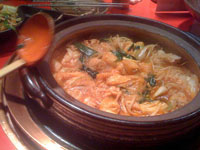 Healthy and easy to cook, Japanese noodles are great options when considering making your next Japanese meal at home. Find the nabe pots, shabu shabu and sukiyaki pots for making that warm and wholesome noodle dish for the fall and winter, or find the perfect set of noodle bowls right here at Mrs. Lin’s Kitchen. Healthy and easy to cook, Japanese noodles are great options when considering making your next Japanese meal at home. Find the nabe pots, shabu shabu and sukiyaki pots for making that warm and wholesome noodle dish for the fall and winter, or find the perfect set of noodle bowls right here at Mrs. Lin’s Kitchen.
|
|
 |
OUR 2014 NEWSLETTERS
Japanese Noodle Galore!
Spam Musubi—the Uniquely Hawaiian Snack
Tanabata Festival: Reunion of deities and making of wishes
Onigiri—Japanese Rice Balls: Traditional Convenience Food
Owls in Japan—Symbolism and Myth
Takoyaki: The street food at the Crossroad of history
White Day: The Reverse Valentine’s Day
Chinese New Year: Flowers of Celebration
Chinese Hot Pot: Gathering around Cooking
NEWSLETTER ARCHIVES
2014
2013
2012
2011
2010
2009
2008
2007
2006
2005
2004
2003
2002
2001
|